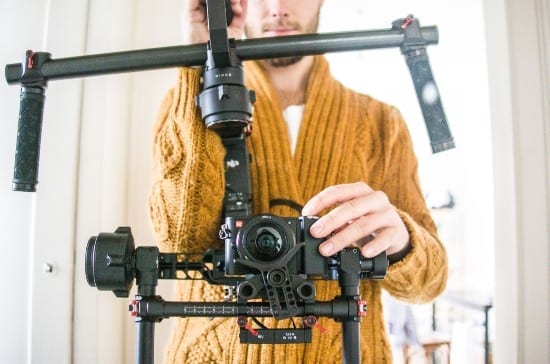Ah, the gimbal! It’ll go down as one of the handiest inventions in filmmaking. But what is a gimbal? In this article, we’re going to jump right into the gimbal – it’s history, uses and benefits for a videographer or filmmaker.
So you want to film a scene where, for example, a character is running from point A to point B in a tracking shot. You can’t afford a Steadicam so you film it handheld.
The resulting footage, however, is too shaky for your taste. It looks like someone’s vacation footage shot with an iPhone after one too many pina coladas.
When what you’re trying to achieve is the sort of silky smooth footage from a David Fincher film.
Let’s drop the vacation shake and make it more Fincher!
What Is a Gimbal?
Throughout history, film studios have usually used expensive and cumbersome tools like steadicams and dolly track to keep the tracking shots smooth.
These tools require skilled operators to use since they are not computer-assisted.
Recently, however, there appeared new tool on the market called a gimbal. The gimbal put smooth tracking shots well within the realms of the budget filmmaker, so they could leave behind the hefty cost of things like steadicams and dollies.
WHAT IS A GIMBAL
What Is A Gimbal?
A gimbal is a device that allows you to capture stabilized, smooth footage from your camera while moving.
The two most common types of stabilization are 3-axis and 2-axis. 3-axis stabilizers counteract all three motions: up/down (yaw), left/right (pitch) and forwards/backwards (roll).
This makes it the preferred type for professionals who want to eliminate camera shake as much as possible.
2-axis stabilizers only compensate for vertical motion which can be good enough if you’re not doing any panning or tilting movements on a tripod.
The gimbal is a compact camera stabilizer, assisted by computer algorithms to keep the footage clean of unwanted shakiness. To say it’s been a revolution for the indie filmmaker or intrepid videographer is an understatement!
In this guide, I’ll explain what a gimbal is, how it works and recommend a few things for aspiring cinematographers to consider if they choose to buy one.
By the end of this guide, you’ll have all the information you need to get the smoothest footage you’ve ever shot!
What Is a Gimbal – The Technicals
A Gimbal is a handheld device that can be operated by a single cameraman. Its main purpose is to reduce the shakiness of handheld footage and give clean and smooth footage output when shooting things like tracking shots.
They are built with a camera mount and motion detectors within them to sense any unwanted movement. Upon sensing the movement, the gimbal uses an algorithm to control its pivots and counteract it as it happens.
Thus, the footage remains stable because the camera was prevented from shaking back and forth by the pivots.
Also, Gimbals are sophisticated enough to tell the difference between an intentional pan and an unwanted camera movement.
A good gimbal is incredibly quiet, as well. They don’t make noise because the brushless motors that adjust the camera only do so subtly – which is exactly what you want, and a major pro in favor of getting acclimatised to a gimbal ASAP.
Let’s say, for example, you’re filming your latest short film. The camera tilts forward as you make a camera move. The gimbal’s motion sensor will transfer the movement data to the computer. The latter will send back an algorithm for the arm.
This algorithm tells it how much counter movement it needs to keep the footage from shaking. Thus the camera stays stable and the result is footage like this:
https://www.youtube.com/watch?v=iAaCS6yhtk8
And all of this data processing is occurring in a split second. Amazing!
Same thing if your camera was tilting clockwise. The algorithm would tell the roll axis to move counter-clockwise to keep the camera stable.
If you’re thinking, “What if I want to deliberately pan the camera?” Don’t worry. gimbals are readily equipped to read intentional camera movements using a different algorithm.
Now that you know how a gimbal works, let’s see how you can equip and use one.
How Do I Set Up a Gimbal?
Gimbals are available for DSLR cameras, mirrorless cameras, smartphones and GoPros.
So, first, you have to pick the right camera for your device. Before you buy a gimbal you have to know if it supports your DSLR camera, for example.
Gimbal suppliers often have a list of their supported devices. For instance, Gudsen has a list of cameras compatible with its MOZA Air 2 Gimbal. So do your research first.
Now that you know what gimbal is a perfect match for your camera, you can set it up. If you’re familiar with setting up tripods, this will be very familiar.
Let’s take a look at the steps:
1. Camera Ready
First, make sure that your camera is ready for the shoot. Check that the battery, memory card, and all other settings are correct before you mount the camera.
Now that the camera is ready, loosen up all the adjustment arms so that you can mount your camera comfortably.
2. Camera Setup
Next, set your camera on the base plate and screw it tight. Make sure it’s not loose unless you want your camera to fall off the gimbal. Don’t be that person who’s paying for expensive mistakes!
Also, don’t forget to make sure that the base plate is pointing straight. Take time to line up this important component.
No products found.
3. Calibration
After the camera is set up safely on the gimbal, you’ll need to calibrate the weight distribution. Now, don’t worry, it sounds more complicated than it actually is.
All you have to do is adjust the pitch arms. For a 3 axis gimbal, the camera should not tilt forward or backward. Nor should it roll clockwise or counterclockwise.
It should be perfectly still as if it’s on a tripod. Then, turn on your camera and then the gimbal itself. As soon as you turn it on, the camera will adjust itself to perfect balance.
4. Activate Functions
Now, all you need is to follow your gimbal’s instructions to activate certain functions. For instance, on the MOZA Air Gimbal, you can press the joystick button once to activate what they call a Yaw Follows.
What this means is that the camera will follow your hand movements. This is perfect for tracking shots and pans.
If, for example, you want the camera to tilt back and forth according to your movements you need to press the joystick button twice.
Every gimbal brand has its own combination of buttons you need to press for whatever actions you want the camera to take. So, some experimentation at first is required until you get used to handling your particular gimbal.
Good luck!
Gimbal vs. Steadicam
If you’re wondering if Hollywood is using gimbals. The answer is no – they don’t. Hollywood cinematographers use what is called a steadicam to achieve smooth footage. We mentioned those at the top of the post.
These are far more expensive and complicated to handle than a gimbal. This is because the filming equipment Hollywood uses is too big and heavy for a conventional gimbal. But the gimbal technology is based on the principles of Hollywood steadicams.
So, if you’re an aspiring cinematographer gimbals are perfect for your uses. You can use them with whatever device you own. There are a few more things to consider before buying one, however.
2 axis Gimbals vs. 3 axis Gimbals
It is important to note the difference between 2 axis and 3 axis Gimbals. Now, as mentioned before, 3 axis cameras feature a stabilized tilt, pan and roll axis.
2 axis gimbals, on the other hand, only stabilize the pan and roll axis. So it seems easy to just say that 3 axis gimbals are superior since they give you more stability.
That’s only partially true because your particular needs will be an even more important deciding factor on what’s superior.
For one, 2 axis gimbals are lighter since they only have two motors. They also eat up less battery for the same reason.
Also, if you’re wondering whether or not the 3 axis gimbals are expensive, yes they are. But price point really depends on a few key points:
- Your goals for the gimbal,
- How much you’re going to use it, and
- Your budget for the project(s).
The other thing to consider is the level of stability you’re looking for. If you want Hollywood level stable footage, then surely you have to go with a 3 axis gimbal.
However, if you just want something that’s passable and don’t want to spend more money you can go for a 2 axis and get some stable enough footage with it.
No products found.
WHAT IS A GIMBAL
Advantages of Using Gimbals
• They make your footage higher quality and look more cinematic.
• You can use heavier cameras without worrying about them falling over or zooming in on close up shots.
• Gimbals are great for filmmakers, photographers, or anyone who wants to create stunning pictures.
Gimbal Considerations
Let’s look at some gimbal considerations that should be top of mind when you purchase your gimbal:
3 Axis Is The Way Forward
While I mentioned predominantly 3 axis models in this article, there are also 2 axis models, which we touched on a little. The latter is cheaper, but if you get the 3 axis you’ll have way more stability and overall better performance.
All About Power
Gimbals are powered in two different ways. The first type uses alkaline batteries which need to be changed regularly.
The second type uses lithium-ion batteries, which you can recharge.
The second type is a no-brainer, right? Well, there’s one thing to consider. Alkaline batteries last longer than Lithium-ion.
Weight
Weight is also important. Trust me, you’ll want a Gimbal that weighs no more than 2 pounds.
Any more weight, combined with the camera, itself will tire your arms pretty quickly if you have to hold the camera for long periods. Think event videography!
However, make sure that your Gimbal is both light-weight and good quality. You don’t want it to break and find your camera flying across someone’s wedding ceremony!
Software Compatability
Also, do your research on what software the Gimbal uses and if it’s compatible with your camera, smartphone, computer, etc. This way you can get more out of the gimbal.
Some things are way easier to do if your gimbal is compatible with your smartphone. You can, for instance, control your camera movement or decide when recording starts via your phone. Handy!
Accessorize!
One last thing to consider, if you want a gimbal for professional usage, is if it allows other accessories to be mounted on it.
This is a requirement if you want to mount tripods to your gimbal, set it on the floor for more of a traditional dolly style shot, mount it to extension poles, etc.
What is a Gimbal – Wrapping Up
In conclusion, gimbals are a revolutionary innovation in the world of cinematography. They pave the way for aspiring filmmakers, especially those who are on a budget, to create seamless, steady and shakiness free footage.
All massively important when it comes to creating exceptional films, videos or anything else beyond a still image!
In the past, this was a luxury only afforded to Hollywood productions. Thankfully, now that gimbals are widely available you don’t need a lot of money or a lot of practice to get the smooth footage you want. You just have to look for the right gimbal for you.
The internet is brimming with reviews of all brands and types of gimbals. You can get a gimbal for your DSLR camera, smartphone, GoPro or even your drone.
There are also numerous videos about how to set up a gimbal and how to use it properly to suit your needs. And we’ve included a couple of those here. So there’s no excuse now, find your gimbal and get filming!
We hope this post on all things camera gimbal has been eye-opening. Got a gimbal tip that we missed? Hit us up in the comments below.
Now get out there and use your gimbal!
We have Gear Buyer’s Guides on every type of Filmmaking Equipment!











